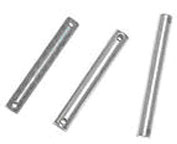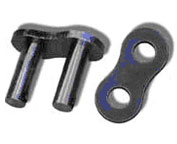 | |  |
|
 The description of an axle is a central shaft used for rotating a wheel or a gear. Where wheeled motor vehicles are concerned, the axle itself may be fixed to the wheels and rotate along with them. In this situation, bearings or bushings are provided at the mounting points where the axle is supported. On the other hand, the axle could be attached to its surroundings and the wheels could in turn revolve around the axle. In this particular situation, a bushing or bearing is located inside the hole within the wheel to enable the wheel or gear to revolve all-around the axle.
When referring to trucks and cars, several references to the word axle co-occur in casual usage. Normally, the term means the shaft itself, a transverse pair of wheels or its housing. The shaft itself turns with the wheel. It is normally bolted in fixed relation to it and known as an 'axle' or an 'axle shaft'. It is equally true that the housing around it which is normally known as a casting is otherwise known as an 'axle' or occasionally an 'axle housing.' An even broader sense of the word refers to every transverse pair of wheels, whether they are connected to one another or they are not. Hence, even transverse pairs of wheels within an independent suspension are generally referred to as 'an axle.'
In a wheeled vehicle, axles are an integral component. With a live-axle suspension system, the axles function so as to transmit driving torque to the wheel. The axles even maintain the position of the wheels relative to one another and to the motor vehicle body. In this particular system the axles must even be able to bear the weight of the motor vehicle along with whichever cargo. In a non-driving axle, like for instance the front beam axle in various two-wheel drive light vans and trucks and in heavy-duty trucks, there would be no shaft. The axle in this particular condition serves only as a steering part and as suspension. Various front wheel drive cars consist of a solid rear beam axle.
The axle serves just to transmit driving torque to the wheels in several types of suspension systems. The angle and position of the wheel hubs is part of the functioning of the suspension system found in the independent suspensions of new SUVs and on the front of several brand new light trucks and cars. These systems still consist of a differential but it does not have connected axle housing tubes. It can be attached to the vehicle frame or body or likewise could be integral in a transaxle. The axle shafts then transmit driving torque to the wheels. The shafts in an independent suspension system are similar to a full floating axle system as in they do not support the motor vehicle weight.
The vehicle axle has a more vague description, meaning that the parallel wheels on opposing sides of the motor vehicle, regardless of their type of mechanical connection to one another.
 Click to Download the pdf Click to Download the pdf
| |
 | |  |
 | |  |
|
-
-
-
-
-
-
Alternators
An alternator is a device that changes mechanical energy into electric energy. This is done in the form of an electrical current. In essence, an AC electrical generator could likewise be called an alternator. The word usually refers to a small, ...
More
-
Brakes
A brake wherein the friction is supplied by a set of brake shoes or brake pads that press against a rotating drum unit called a brake drum. There are a few particular differences among brake drum kinds. A "brake drum" is commonly the definition ...
More
-
Carriage Rollers
Particularly designed bearings known as carriage rollers are frequently seen on lift masts because they allow them to function better within tough environmental surroundings. The typical lift mast is regularly subject to frequent oscillations, ...
More
| |
 | |  |





























